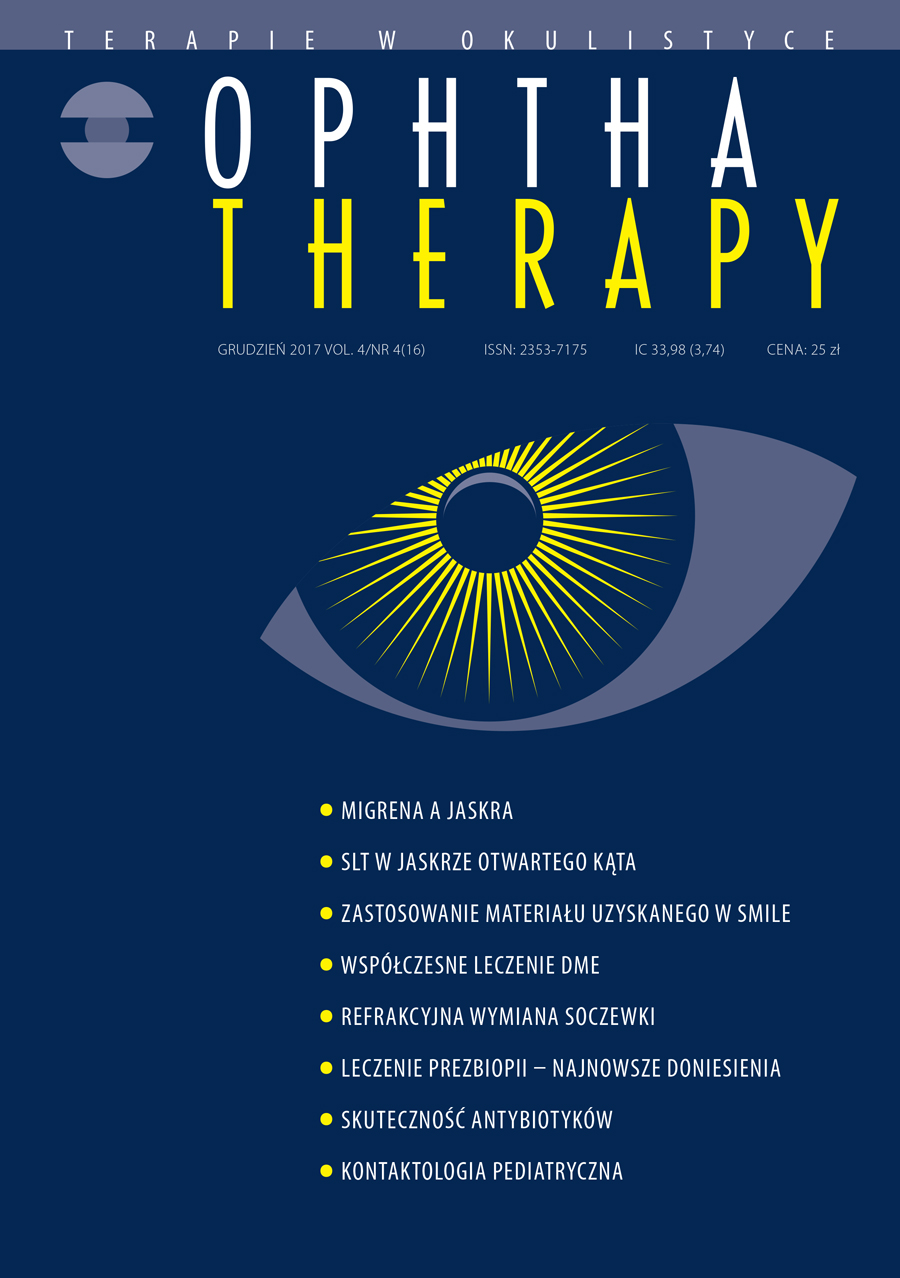Zastosowanie tkanki stromy rogówki uzyskanej podczas zabiegu SMILE w chirurgii refrakcyjnej i leczeniu stożka rogówki
##plugins.themes.bootstrap3.article.main##
Abstrakt
W artykule dokonano przeglądu aktualnego piśmiennictwa na temat użycia ludzkiej tkanki stromy rogówki pozyskanej w czasie zabiegu SMILE (Small Excision Lenticule Extraction) w chirurgii refrakcyjnej i leczeniu choroby ektatycznej. Większość przytaczanych prac ma charakter unikalny i pionierski. Choć wyniki zabiegów dotyczą niewielkich grup pacjentów, to obserwacje te dają solidne podstawy do dalszego rozwoju tych technik i badań nad nimi.
Pobrania
##plugins.themes.bootstrap3.article.details##

Utwór dostępny jest na licencji Creative Commons Uznanie autorstwa – Użycie niekomercyjne – Bez utworów zależnych 4.0 Międzynarodowe.
Copyright: © Medical Education sp. z o.o. License allowing third parties to copy and redistribute the material in any medium or format and to remix, transform, and build upon the material, provided the original work is properly cited and states its license.
Address reprint requests to: Medical Education, Marcin Kuźma (marcin.kuzma@mededu.pl)
Bibliografia
2. Binder PS, Zwada EY, Deg JK et al. Hydrophilic lenses for refractive keratoplasty: the use of factory lathed materials. Contact Lens Association of Ophthalmologist Journal. 1984; 10: 105-11.
3. Samples JR, Binder PS, Zwada EY et al. Morphology of hydrogel implants used for refractive keratoplasty. Invest Ophthalmol Vis Sci. 1984; 25: 843-50.
4. Dexl AK, Jell G, Strohmaier C et al. Long-term outcomes after monocular corneal inlay implantation for the surgical compensation of presbyopia. J Cataract Refract Surg. 2015; 41: 566-75.
5. Zhang T, Sun Y, Liu M et al. Femtosecond Laser-assisted Endokeratophakia Using Allogeneic Corneal Lenticule in a RabbitModel. J Refract Surg. 2015; 31(11): 775-82.
6. Lindstrom RL, MacRae SM, Pepose JS et al. Corneal inlays for presbyopia correction. Curr Opin Ophthalmol. 2013; 24: 281-7.
7. Mohamed-Noriega K, Toh KP, Poh R et al. Cornea lenticule viability and structural integrity after refractive lenticule extraction (ReLEx) and cryopreservation. Mol Vis. 2011; 17: 3437-49.
8. Angunawela RI, Riau AK, Chaurasia SS et al. Refractive lenticule re-implantation after myopic ReLEx: a feasibilitystudy of stromal restoration after refractive surgery in a rabbit model. Invest Ophthalmol Vis Sci. 2012; 53: 4975-85.
9. Riau AK, Angunawela RI, Chaurasia SS et al. Reversible femtosecond laser-assisted myopia correction: a non-human primate study of lenticule re-implantation after refractive lenticule extraction. Public Library of Science One. 2013; 8: e67058.
10. Liu H, Zhu W, Jiang AC et al. Femtosecond laser lenticule transplantation in rabbit cornea: experimental study. J Refract Surg. 2012; 28: 907-11.
11. Wilson SE. Analysis of the keratocyte apoptosis, keratocyte proliferation, and myofibroblast transformation responses after photorefractive keratectomy and laser in situ keratomileusis. Trans Am Ophthalmol Soc. 2002; 100: 411-33.
12. Jacob S , Kumar DA, Agarwal A et al. Evidence of Successful Near Vision Enhancement With a New Technique: PrEsbyopic Allogenic Refractive Lenticule (PEARL) Corneal Inlay Using a SMILE Lenticule. J Refract Surg. 2017; 33(4): 224-9.
13. Barraquer JI. Queratomileusis y queratofakia. Instituto Barraquer de América, Bogotá 1980: 342.
14. Pradhan KR, Reinstein DZ, Carp GI et al. Femtosecond laser-assisted keyhole endokeratophakia: correction of hyperopia by implantation of an allogeneic lenticule obtained by SMILE from a myopic donor. J Refract Surg. 2013; 29: 777-82.
15. Sun L, Yao P, Li M et al. The Safety and Predictability of Implanting Autologous Lenticule Obtained by SMILE for Hyperopia. J Refract Surg. 2015; 31(6): 374-9.
16. Ganesh S, Brar S, Rao PA. Cryopreservation of extracted corneal lenticules after small incision lenticule extraction for potential use in human subjects. Cornea. 2014; 33: 1355-62.
17. Studer HP, Pradhan KR, Reinstein DZ et al. Biomechanical modeling of femtosecond laser keyhole endokeratophakia surgery. J Refract Surg. 2015; 31: 480-6.
18. Spoerl E, Mrochen M, Sliney D et al. Safety of UVA – riboflavin cross-linking of the cornea. Cornea. 2007; 26: 385-9.
19. Wollensak G, Spörl E, Reber F et al. Corneal endothelial cytotoxicity of riboflavin/UVA treatment in vitro. Ophthalmic Res. 2003; 35: 324-8.
20. Hafezi F, Mrochen M, Iseli HP et al. Collagen cross-linking with ultraviolet-A and hypoosmolar riboflavin solution in thin corneas. J Cataract Refract Surg. 2009; 35: 621-4.
21. Sachdev MS, Gupta D, Sachdev G et al. Tailored stromal expansion with a refractive lenticule for crosslinking the ultrathin cornea. J Cataract Refract Surg. 2015; 41: 918-23.
22. Fadlallah A, Dirani A, Rami HE et al. Safety and visual outcome of Visian toric ICL implantation after corneal collagen cross linking in keratoconus. J Refract Surg. 2013; 29: 84.
23. Coskunseven E, Jankov MR, Hafezi F et al. Effect of treatment sequence in combined intrastromal corneal rings and corneal collagen crosslinking for keratoconus. J Cataract Refract Surg. 2009; 35: 2084-91.
24. Kymionis GD, Portaliou DM, Diakonis VF et al. Posterior linear stromal haze formation after simultaneous photorefractive keratectomy followed by corneal collagen cross-linking. Invest Ophthalmol Vis Sc.i 2010; 51: 5030-3.
25. Ganesh S, Sheetal Brar S. Femtosecond Intrastromal Lenticular Implantation Combined With Accelerated Collagen Cross-Linking for the Treatment of Keratoconus – Initial Clinical Result in 6 Eyes. Cornea. 2015; 34: 1331-9.
26. Mulet M, Alio JL, Knorz MC. Hydrogel intracorneal inlays for the correction of hyperopia: outcomes and complications after 5 years of follow-up. Ophthalmology. 2009; 116(8): 1455-60.
27. Luengo-Gimeno F, Tan DT, Mehta JS. Evolution of deep anterior lamellar keratoplasty (DALK). Ocul Surf. 2011; 9: 98-110

